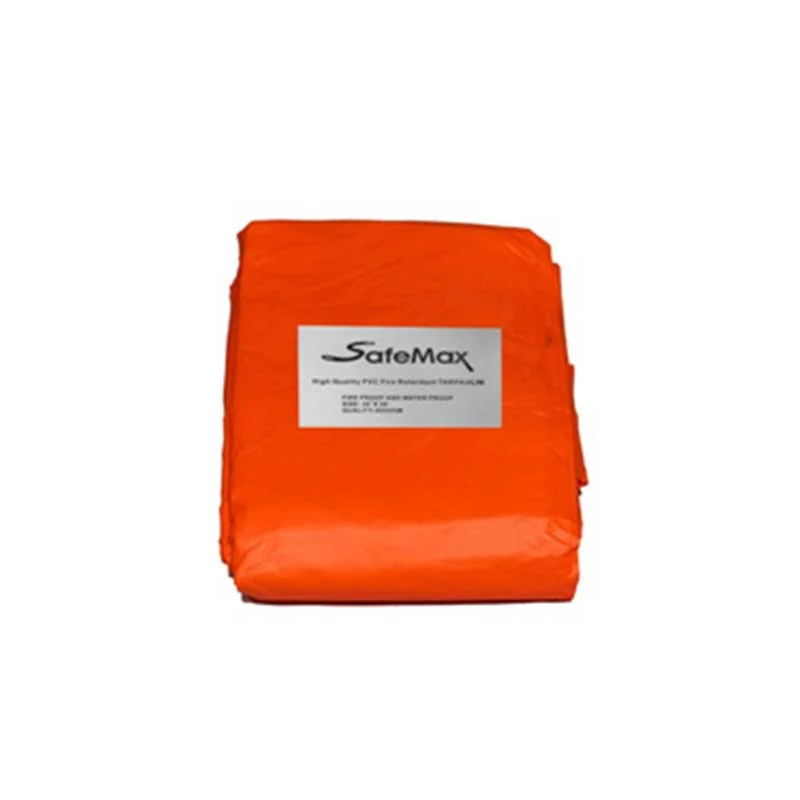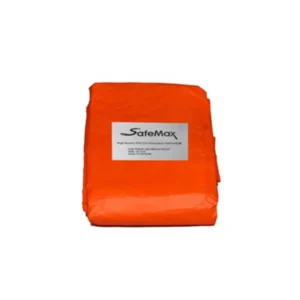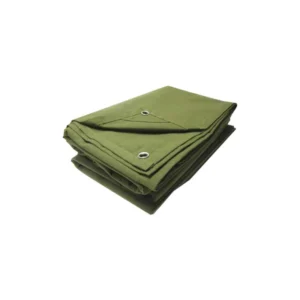Are you in need of a quality tarpaulin but not sure where to start?
Look no further! In this comprehensive guide, Discover everything about tarpaulin, from selection to maintenance. Whether you’re camping, safeguarding belongings, or covering equipment, this guide is for you. Explore tarp types, assess material quality, and learn usage tips. We’ll cover securing, UV resistance, and maintenance to extend lifespan. Make informed decisions and find the ideal tarpaulin for your needs effortlessly.
Types of Tarpaulin and Their Uses
PVC Tarpaulin
PVC tarpaulin are robust, weather-resistant covers that offer unparalleled protection against rain, wind, and UV rays. Their durability and resilience make them indispensable in outdoor settings, providing reliable shelter during events, construction projects, and agricultural activities. Whether shielding equipment from moisture on construction sites or protecting crops from adverse weather conditions in agriculture, PVC tarpaulin prove their versatility and effectiveness. Their ability to withstand harsh elements while maintaining structural integrity ensures peace of mind and enhanced productivity in various industries.
Canvas Fire Retardant Tarpaulin
GET IT NOW
Canvas fire retardant tarpaulin are engineered to endure extreme temperatures and flames, making them essential safety equipment in environments prone to fire hazards. In workshops and industrial sites, these tarpaulin act as critical barriers against sparks, welding debris, and potential ignition sources. Their ability to withstand fire makes them invaluable assets for protecting personnel, equipment, and structures from the devastating effects of fires. Additionally, canvas fire retardant tarpaulin play a vital role in emergency response situations, where they are deployed to create firebreaks and contain wildfires, ensuring the safety of communities and responders alike.
Canvas Tarpaulin
GET IT NOW
Canvas tarpaulin are renowned for their durability and breathability, making them ideal for a wide range of applications. Whether covering goods during transportation, creating temporary shelters in outdoor settings, or serving as canvases for artistic endeavors, canvas tarpaulin offer versatility and reliability. Their robust construction allows them to withstand wear and tear, providing long-lasting protection and support. Additionally, the breathable nature of canvas tarpaulin prevents condensation buildup, ensuring the preservation of covered items while minimizing moisture-related damage. From practical to creative uses, canvas tarpaulin remain a staple for individuals and industries seeking dependable coverage and versatility.
Factors to Consider When Choosing a Tarpaulin
Durability
Assessing a tarpaulin durability involves evaluating its material’s strength and resilience against various forms of damage. This includes resistance to tearing, puncturing, and degradation from UV exposure. A durable tarpaulin ensures longevity and reliable protection, making it suitable for demanding environments and applications where it may encounter rough handling or adverse weather conditions.
Size and Shape
Choosing the right size and shape of a tarpaulin is crucial to ensure optimal coverage and effectiveness for its intended use. It’s essential to select dimensions that match the specific requirements of the application, whether it’s covering equipment, creating a shelter, or securing a load during transportation. Properly sized tarps minimize waste and ensure comprehensive protection, enhancing efficiency and safety.
Waterproofing
Waterproofing is essential to prevent moisture infiltration and protect the contents or area covered by the tarpaulin. Opting for waterproof or water-resistant coatings ensures that the tarpaulin remains impervious to rain, snow, and other forms of precipitation. This feature is particularly critical for outdoor applications where exposure to moisture can lead to damage, corrosion, or mold growth, compromising the integrity of the covered items.
UV Protection
UV-resistant tarpaulin withstand prolonged exposure to sunlight without deteriorating or losing their effectiveness. UV protection helps prolong the lifespan of the tarpaulin, preventing it from becoming brittle, faded, or weakened over time. This feature is especially important for outdoor applications where UV radiation can cause degradation and reduce the tarpaulin performance and durability. Choosing UV-resistant tarpaulin ensures long-term reliability and cost-effectiveness in outdoor settings.
Weight and Portability
Balancing weight and portability is crucial when selecting a tarpaulin, as it determines ease of handling and transportation. While sturdiness is essential for durability and protection, excessive weight can hinder maneuverability and increase logistical challenges. Choosing a tarpaulin that strikes the right balance between weight and portability ensures practicality and efficiency in various applications, allowing for easy deployment, storage, and transport without compromising on performance or durability.
How to Properly Use a Tarpaulin
Secure Fastening
Properly securing a tarpaulin is essential to ensure it remains in place and provides effective coverage. Utilizing sturdy ropes, bungee cords, or clamps, anchor the tarpaulin securely to fixed points such as poles, stakes, or anchor points on vehicles or structures. Ensure that the fastening materials are robust and tightly secured to withstand wind, movement, or external forces. Pay attention to evenly distributing tension during fastening to prevent stress points and potential tearing.
Proper Orientation
Correctly orienting the tarpaulin plays a significant role in its effectiveness. Position the tarpaulin to allow water runoff by ensuring that it slopes downward from its highest point to the edges. This prevents pooling of water, which can cause damage, weight strain, and compromise structural integrity, especially on flat surfaces. Additionally, consider wind direction and potential impact to minimize the risk of wind lifting or displacing the tarpaulin.
Tension Distribution
Evenly distributing tension across the tarpaulin is essential to prevent sagging and promote stability. Avoid overstretching the tarpaulin, as this can lead to weak spots and increased vulnerability to tearing or damage. Instead, adjust tension gradually and systematically, ensuring that the tarpaulin maintains a smooth, taut surface without excessive strain on any particular area. Pay attention to corners and edges, where tension tends to concentrate, and reinforce as needed to maintain uniform tension throughout.
Regular Inspections
Periodically inspecting the tarpaulin is crucial for identifying and addressing any issues promptly to maintain its effectiveness. Check for tears, abrasions, or signs of wear that may compromise the tarpaulin integrity or protective capabilities. Additionally, examine fastenings and anchor points to ensure they remain secure and intact. Address any issues discovered during inspections promptly by repairing tears, reinforcing fastenings, or replacing damaged components to prevent further damage and ensure continued reliability. Regular maintenance and inspections prolong the lifespan of the tarpaulin and enhance its performance in protecting covered items or areas.
Common Mistakes to Avoid When Using Tarpaulins
Inadequate Fastening
One common mistake when using tarpaulin is failing to secure them properly. Inadequate fastening can lead to wind displacement, where the tarpaulin is blown away or shifted from its intended position, leaving the covered items exposed to the elements. Additionally, improper fastening may result in water leakage, as gaps or loose areas allow moisture to seep through, potentially causing damage to the covered items. To avoid these issues, ensure that the tarpaulin is securely anchored using sturdy ropes, bungee cords, or clamps, and regularly check the fastenings to maintain their effectiveness.
Overstretching
Another mistake to avoid is overstretching the tarpaulin during installation. Excessive tension can strain the fabric and weaken its integrity over time, making it more susceptible to tears, punctures, or failure. Overstretching may also cause stress points, where the fabric is stretched beyond its limits, leading to premature wear and deterioration. To prevent this, apply tension to the tarpaulin gradually and evenly, avoiding excessive force that could compromise its structural integrity. Regularly inspect the tarpaulin for signs of overstretching and adjust tension as needed to maintain optimal performance.
Ignoring Maintenance
Neglecting regular maintenance is a common mistake that can significantly impact the lifespan and effectiveness of tarpaulin. Failure to clean, inspect, and repair the tarpaulin as needed can result in accelerated deterioration and reduced performance over time. Dust, dirt, and debris can accumulate on the tarpaulin’s surface, leading to staining, mold growth, and degradation of the fabric. Additionally, tears, holes, or other damage left unattended can worsen over time, compromising the tarpaulin’s ability to provide adequate protection. To avoid these issues, establish a routine maintenance schedule that includes cleaning, inspection, and timely repairs to keep the tarpaulin in optimal condition.
Improper Storage
Improper storage of tarpaulin can also lead to various problems, including mold growth and material deterioration. Storing tarpaulin in damp or humid conditions creates an ideal environment for mold and mildew to thrive, which can cause staining, odor, and structural damage to the fabric. Additionally, exposure to moisture over time can weaken the tarpaulin’s fibers, leading to degradation and reduced effectiveness. To prevent these issues, store tarpaulin in a dry, well-ventilated area away from direct sunlight, and ensure they are properly cleaned and dried before storage. By storing tarpaulin correctly, you can prolong their lifespan and maintain their quality for future use.
Common Mistakes to Avoid When Using Tarpaulins
Inadequate Fastening
One of the most critical mistakes to avoid when using tarpaulin is failing to secure them adequately. Insufficient fastening can lead to disastrous consequences such as wind displacement or water leakage. In windy conditions, an inadequately fastened tarpaulin may become dislodged or torn off, leaving the items it was meant to protect vulnerable to the elements. Similarly, if the tarpaulin is not properly secured around its edges or corners, water may seep through gaps, causing damage or spoilage to the covered items. To prevent these issues, ensure that the tarpaulin is securely anchored using sturdy ropes, bungee cords, or clamps, paying special attention to areas prone to wind exposure and water runoff.
Overstretching
Overstretching the tarpaulin during installation is another common mistake that can compromise its integrity over time. Excessive tension places undue stress on the fabric, leading to weakening, stretching, or even tearing. This can result in premature wear and reduced effectiveness of the tarpaulin in providing protection. Additionally, overstretching may cause the tarpaulin to develop stress points, where the fabric is stretched beyond its limits, making it more susceptible to damage. To avoid this, apply tension gradually and evenly across the tarpaulin, avoiding excessive force that could strain the fabric. Regularly inspect the tarpaulin for signs of overstretching and adjust tension as needed to maintain optimal performance.
Ignoring Maintenance
Neglecting regular maintenance is another mistake that can significantly impact the lifespan and effectiveness of tarpaulin. Failure to clean, inspect, and repair the tarpaulin as needed can lead to accelerated deterioration and reduced performance over time. Dust, dirt, and debris can accumulate on the tarpaulin’s surface, leading to staining, mold growth, and degradation of the fabric. Additionally, tears, holes, or other damage left unattended can worsen over time, compromising the tarpaulin’s ability to provide adequate protection. To avoid these issues, establish a routine maintenance schedule that includes cleaning, inspection, and timely repairs to keep the tarpaulin in optimal condition.
Improper Storage
Improper storage of tarpaulin can also lead to various problems, including mold growth and material deterioration. Storing tarpaulin in damp or humid conditions creates an ideal environment for mold and mildew to thrive, which can cause staining, odor, and structural damage to the fabric. Additionally, exposure to moisture over time can weaken the tarpaulin’s fibers, leading to degradation and reduced effectiveness. To prevent these issues, store tarpaulin in a dry, well-ventilated area away from direct sunlight, and ensure they are properly cleaned and dried before storage. By storing tarpaulin correctly, you can prolong their lifespan and maintain their quality for future use.
Where to Buy High-Quality Tarpaulin
Specialty Retailers
One of the most reliable places to purchase high-quality tarpaulin is from specialty retailers that specialize in outdoor equipment, construction supplies, or agricultural products. These retailers often carry a wide range of tarpaulin options, catering to various needs and applications. By shopping at reputable specialty stores, you can benefit from the expertise of knowledgeable staff who can guide you in selecting the right type and size of tarpaulin for your specific requirements. Additionally, these retailers typically offer products from trusted brands known for their durability and performance, giving you peace of mind regarding the quality of your purchase.
Online Marketplaces
Online marketplaces provide a convenient and accessible platform for purchasing high-quality tarpaulin. Platforms such as Amazon, eBay, and Walmart offer a vast selection of tarpaulins from various sellers, allowing you to compare prices, read customer reviews, and choose the best option for your needs. Many online marketplaces also offer competitive pricing and frequent discounts, making it easier to find affordable yet reliable tarpaulins. However, it’s essential to research the seller’s reputation and read product descriptions carefully to ensure that you’re purchasing from a reputable source and getting the quality you expect.
Direct Manufacturers
Another option for purchasing high-quality tarpaulins is to buy directly from manufacturers. Many tarpaulins manufacturers sell their products directly to consumers through their websites or authorized distributors, offering competitive pricing and customization options. By purchasing directly from the manufacturer, you can ensure that you’re getting genuine products of the highest quality, as well as access to exclusive deals and promotions. Additionally, buying from manufacturers allows you to communicate directly with the source, enabling you to ask questions, request samples, and receive personalized assistance to meet your specific requirements.
DIY Projects Using Tarpaulins
Garden Shade Canopy
A garden shade canopy made from a tarpaulins provides an excellent way to create a shaded retreat in your backyard, perfect for relaxation or outdoor gatherings. To make this DIY project, you’ll need a sturdy frame structure such as wooden posts or metal poles arranged in the desired shape and size. Drape the tarpaulins over the frame and secure it in place using ropes or bungee cords, ensuring that it is taut and covers the entire area you want shaded. You can adjust the height and angle of the canopy to control the amount of shade provided. This project offers a cost-effective and customizable solution for adding shade to your outdoor space, allowing you to enjoy your garden even on hot sunny days.
Camping Shelter
A tarpaulins camping shelter is a versatile and lightweight option for providing protection from the elements during outdoor adventures. To create a makeshift shelter, you’ll need a tarpaulins large enough to cover the desired area, along with sturdy poles or trees to support it. Erect the poles or tie ropes between trees to create a framework for the tarpaulins, then drape the tarpaulins over the structure and secure it in place using ropes or stakes. You can adjust the height and angle of the tarpaulins to suit your needs, providing shelter from rain, sun, or wind while camping or hiking. This DIY project offers a portable and cost-effective solution for staying comfortable and protected in the great outdoors.
Truck Bed Cover
A tarpaulins truck bed cover is a practical and affordable way to protect your cargo during transportation, whether you’re moving furniture, hauling supplies, or transporting outdoor gear. To make a truck bed cover, you’ll need a tarpaulins large enough to cover the entire bed of your truck, along with tie-down straps or bungee cords for securing it in place. Simply spread the tarpaulins over the truck bed and use tie-down straps to secure it tightly to the bed rails or anchor points. Ensure that the tarpaulins is evenly distributed and taut to prevent it from flapping or coming loose during transit. This DIY project offers a simple and effective solution for keeping your cargo safe and dry while on the road.
Tarpaulins Alternatives for Specific Needs
Polyethylene Tarps
Polyethylene tarps, often referred to as poly tarps, are lightweight and economical alternatives to traditional canvas or vinyl tarps. The construction of these tarps from high-density polyethylene (HDPE) material provides excellent durability and resistance to tears, water, and UV rays. Poly tarps are commonly used for short-term projects or events where temporary coverage is needed, such as construction sites, camping trips, or outdoor gatherings. They are available in a variety of sizes, colors, and thicknesses to suit different needs and preferences. While polyethylene tarps may not offer the same level of durability as vinyl tarps, they are cost-effective, easy to handle, and versatile for a wide range of applications.
Vinyl Tarps
Vinyl tarps exhibit exceptional strength, durability, and resistance to harsh environmental conditions. These tarps are constructed from PVC (polyvinyl chloride) material, which provides superior waterproofing, UV protection, and tear resistance compared to other tarp materials. Vinyl tarps are commonly used for long-term outdoor storage, industrial applications, and heavy-duty protection needs where reliability and longevity are essential. They are suitable for covering equipment, machinery, vehicles, and construction materials, providing reliable protection against rain, snow, wind, and sunlight. While vinyl tarps may be more expensive than polyethylene tarps, their superior durability and performance make them a preferred choice for demanding applications requiring long-term outdoor exposure.
For further insights or to discuss your unique requirements, we invite you to connect with us Explore the unparalleled expertise and quality solutions that Shabbir Enterprises brings to the table, ensuring your material handling equipment’s needs are met with precision and reliability
More to Explore
Tarpaulin FAQs Guide
Arrestors: Lineman Belt Essentials
Trolleys: From Manual to Geared
Fire Blankets: Blanket Fire Safety: A Guide to Fire Blankets


